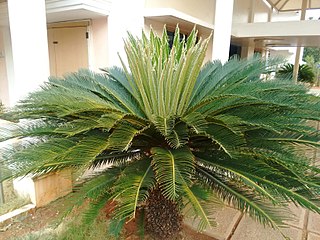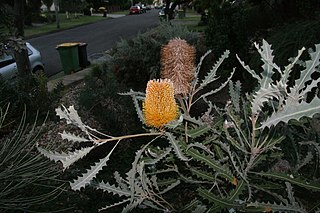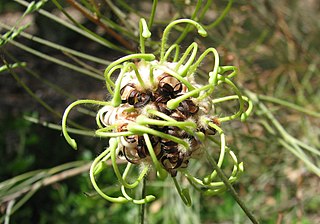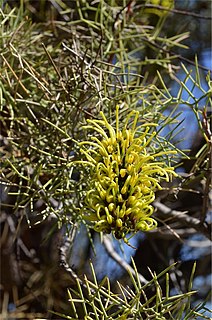
Cycas is a genus of plants belonging to a very ancient lineage, the Cycadophyta, which are not closely related to palms, ferns, trees or any other modern group of plants. They are evergreen perennials which achieved their maximum diversity in the Jurassic and Cretaceous periods, when they were distributed almost worldwide. At the end of the Cretaceous, when the non-avian dinosaurs became extinct, so did most of the cycas in the Northern Hemisphere.

The unofficial geographic term Northern Australia includes those parts of Queensland and Western Australia north of latitude 26° and all of the Northern Territory. Those local government areas of Western Australia and Queensland that lie partially in the north are included.

Asteromyrtus is a genus of flowering plants in the Myrtaceae family. Asteromyrtus was described as a genus in 1843. It is closely related to Callistemon and Melaleuca. The genus was subsequently subsumed into Melaleuca and Sinoga, but was reinstated by Lyndley Craven in 1988 to accommodate seven species, all of which are tropical shrubs or small trees native to New Guinea, Maluku, or northern Australia.
- Asteromyrtus angustifolia - N Queensland
- Asteromyrtus arnhemica - N Northern Territory, N Western Australia
- Asteromyrtus brassii - S New Guinea, N Queensland
- Asteromyrtus lysicephala - S New Guinea, N Queensland
- Asteromyrtus magnifica - N Northern Territory
- Asteromyrtus symphyocarpa – liniment-tree - S New Guinea, N Queensland, N Northern Territory
- Asteromyrtus tranganensis - Aru Islands in Maluku
Bambusa arnhemica is one of three bamboo species native to Australia. It grows in the northwestern areas of the Northern Territory, and is common on riverbanks in Kakadu. Stems turn orange yellow as they harden. Upper stems and branches arch gracefully. It grows to about 8 m in height. It is available from specialist nurseries.
Cycas arnhemica is a species of cycad in the genus Cycas, native to Australia, in the northwest of Northern Territory in Arnhem Land, after which it is named.
Utricularia arnhemica is an affixed aquatic or terrestrial carnivorous plant that belongs to the genus Utricularia. It is endemic to the Arnhem Land area in the Northern Territory of Australia.

Banksia ashbyi subsp. boreoscaia is a shrubby, fire-tolerant subspecies of Banksia ashbyi. It is the lignotuberous form of the species, and occurs along the north-west coast of Western Australia, between Carnarvon and North West Cape.
Grevillea agrifolia, the blue grevillea, is a tree or shrub which is native to the north of Western Australia and the Northern Territory.
Grevillea pteridifolia is a species of Grevillea native to Australia. Common names include silky grevillea, Darwin silky oak, ferny-leaved silky oak, fern-leaved grevillea, golden grevillea, golden tree and golden parrot tree. It occurs in Western Australia, Northern Territory, and Queensland.

Hakea minyma, commonly known as watjula, is a species of shrub that is endemic to Australia. It has long, flat leaves, fragrant pink or white flower from late winter to spring.

Grevillea globosa is a shrub in the family Proteaceae. It is endemic to Western Australia, occurring in the northern wheatbelt.

Persoonia falcata, commonly known as the wild pear, is a shrub native to northern Australia.

Grevillea refracta, commonly known as the silver-leaf grevillea, is a species of plant in the protea family that is native to northern Australia.

Hakea divaricata, commonly known as needlewood, corkbark tree or fork-leaved corkwood, is a tree or shrub in the family Proteaceae native to an area in central Australia. A slow growing species with up to 120 showy cream to greenish-yellow flowers in long racemes from June to November.
Ammannia arnhemica is a species in the family Lythraceae that is endemic to northern Australia.
The East Arnhem land gehyra is a species of gecko. It is endemic to Northern Territory in Australia.
Asteromyrtus angustifolia is a species of plant in the myrtle family Myrtaceae that is endemic to north-eastern Queensland, Australia.
Asteromyrtus brassii, also known as Brass’s Asteromyrtus, is a species of plant in the myrtle family Myrtaceae that is native to New Guinea and Australia.
Asteromyrtus lysicephala, also known as Kennedy’s Heath or Lockhart River Tea-tree, is a species of plant in the myrtle family Myrtaceae that is native to the Aru Islands, southern New Guinea and northern Australia.
Asteromyrtus magnifica is a species of plant in the myrtle family Myrtaceae that is endemic to the Northern Territory of Australia.








